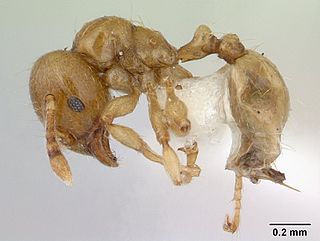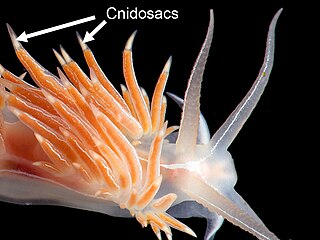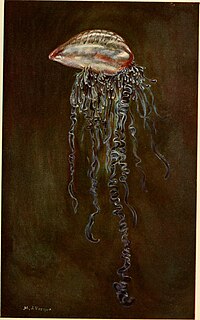
The Portuguese man o' war, also known as the man-of-war, is a marine hydrozoan found in the Atlantic Ocean and the Indian Ocean. It is considered to be the same species as the Pacific man o' war or blue bottle, which is found mainly in the Pacific Ocean. The Portuguese man o' war is the only species in the genus Physalia, which in turn is the only genus in the family Physaliidae.

Siphonophorae is an order within Hydrozoa, which is a class of marine organisms within the phylum Cnidaria. According to the World Register of Marine Species, the order contains 175 species.

Physalia is a genus of the order Siphonophorae, colonies of four specialized polyps and medusoids that drift on the surface of the Atlantic, Indian and Pacific oceans. Although these organisms look like a single multicellular organism, each specimen is actually a colony of minute organisms called zooids that have to work together for survival. A gas-filled bladder resembling a blue bottle provides buoyancy, and long tentacles of venomous cnidocytes provide a means of capturing prey. A sail on the float, which may be left or right-handed, propels Physalia about the sea, often in groups. These siphonophores sometimes become stranded on beaches, where their toxic nematocysts can remain potent for weeks or months in moist conditions. Both species of this siphonophore resemble a jellyfish in appearance, with their gas-filled float and cluster of polyps beneath, which can hang up to 30 or 165 feet below the surface of the sea.

Allomerus decemarticulatus is an Amazonian ant species found in the tropics of South America. This species is most notable for the workers’ complex and extreme predatory behavior, which involves a symbiosis with both a plant and fungal species. They live in leaf pockets of a host plant species, Hirtella physophora. These leaf pockets are areas inside of the plant between the leaves and the stem. Each colony, which consists of about 1,200 workers, inhabits a single tree; however, the ants are spread among the leaf pockets, with typically 40 workers per pocket. Their diet primarily consists of large insects that are captured on the plant, but they also eat some kinds of food bodies produced by the plant as well as its nectar. They are able to capture their prey, which is much larger than themselves, by constructing a platform that acts as a trap for the unsuspecting prey. The ants hide in the trap and attack when any insect lands on it. This technique is an example of ambush predation.
María de los Ángeles Alvariño González, known as Ángeles Alvariño, was a Spanish fishery research biologist and oceanographer globally recognized as an authority in plankton biology. She was the first woman ever appointed as scientist aboard any British or Spanish exploration ship. She discovered 22 new species of marine animals and published over a hundred scientific books, essays, and articles. In her late career she studied the history of early marine scientific exploration.

Marrus orthocanna is a species of pelagic siphonophore, a colonial animal composed of a complex arrangement of zooids, some of which are polyps and some medusae. Swimming independently in the mid-ocean, it lives in the Arctic and other cold, deep waters. It is a colonial creature that is born from a single egg which is fertilized. Later on, a protozoan form that eventually grows to form more duplicating members of the colony. It belongs to the order siphonophorae and the family Marrus. Other species in the family include the Marrus antarcticus, Marrus claudanielis, and Marrus orthocannoides.

Apolemia is a genus of siphonophores. It is the only genus in the monotypic family Apolemiidae.

Dendrogramma enigmatica is a species of siphonophore, the only one in its genus. It has been first described in 2014 on the basis of its morphology from a collection of specimens gathered in 1986. Its taxonomic affinity among animals was then unclear, but RNA from new specimens in 2016 allowed it to be identified as a siphonophore by barcoding and phylogenomics. The specimens are presumed to represent parts (bracts) of an entire siphonophore that has not been identified yet.

A cnidosac is an anatomical feature that is found in the group of sea slugs known as aeolid nudibranchs, a clade of marine opisthobranch gastropod molluscs. A cnidosac contains cnidocytes, stinging cells that are also known as cnidoblasts or nematocysts. These stinging cells are not made by the nudibranch, but by the species that it feeds upon. However, once the nudibranch is armed with these stinging cells, they are used in its own defense.

Muggiaea is a genus of siphonophores in the family Diphyidae. Members of this family are colonial siphonophores with two nectophores arranged one behind the other, but in the genus Muggiaea, the posterior nectophore is absent. The anterior one has a complete dorsal ridge. The somatocyst is very close to the nectosac wall.

Muggiaea atlantica is a species of small hydrozoan, a siphonophore in the family Diphyidae. It is a cosmopolitan species occurring in inshore waters of many of the world's oceans, and it has colonised new areas such as the North Sea and the Adriatic Sea. It is subject to large population swings, and has been held responsible for the death of farmed salmon in Norway. The species was first described by J.T. Cunningham in 1892 from a specimen obtained at Plymouth, England.

Bathyphysa conifera, sometimes called the flying spaghetti monster, is a bathypelagic species of siphonophore in the family Rhizophysidae.

Cystonectae is a suborder of siphonophores. It includes the Portuguese man o' war and Bathyphysa conifera, sometimes called the "flying spaghetti monster."

Physonectae is a suborder of siphonophores. In Japanese it is called 胞泳.

Calycophorae is a suborder of Siphonophores alongside two other suborders Physonectae and Cystonectae. This suborder includes the giant siphonophore, ; one of the longest lengthwise extant creatures (40–50m). While the Physonectae have a pneumatophore, nectophore, and a siphosome, Cystonectae lack a nectophore, and Calycophorae lack a pneumatophore. From the bell-shaped nectophores, Physonectae and Calycophorae are called Codonophores or Greek for bell-bearers. The distribution, morphology, and behaviors of Calycophorae species are vast and greatly depend on the species. Calycophoraes typically consist of two nectophores with a siphosome that have many tentacles that grow out of the siphosome. The Calycophoraes move by propelling water out of the nectophore much like how jellyfishes move. The tentacles act as fishing nets where the nematocysts on the tentacles paralyze their prey which are then later fed on. Calycophorae have three life stages, which are the larval development stage, the polygastric stage, and the eudoxid maturation stage. Each Calycophorae colony forms from one fertilized egg.

Abyla is a genus of colonial siphonophore in the subfamily Abylidae and the suborder Calycophorae. The genus contains three species and was established by Quoy and Gaimard in 1827.
Bassia is a monotypic siphonophore genus in the family Abylidae. The genus contains the single species Bassia bassensis.
Physophoridae is a family of siphonophores.

Abylopsis tetragona is a species of siphonophore in the family Abylidae.

Abyla haeckeli is a colonial siphonophore in the family Abylidae. It was described in 1908.














